 In and around the central chamber were large amounts of cremated bone, fragments of mushroom headed antler pins and a stone ball.
A secondary cremation inside the boulder circle was from the Neolithic Beaker period, around 2500 BCE but the original construction was dated to about 4200 BCE.
In and around the central chamber were large amounts of cremated bone, fragments of mushroom headed antler pins and a stone ball.
A secondary cremation inside the boulder circle was from the Neolithic Beaker period, around 2500 BCE but the original construction was dated to about 4200 BCE.
South is marked by a distant hill but is not on the top [Pic] as it is from Tomb 3, c.200m to the east and c.800 years earlier.
North is in a dip between two hills. [Pic].
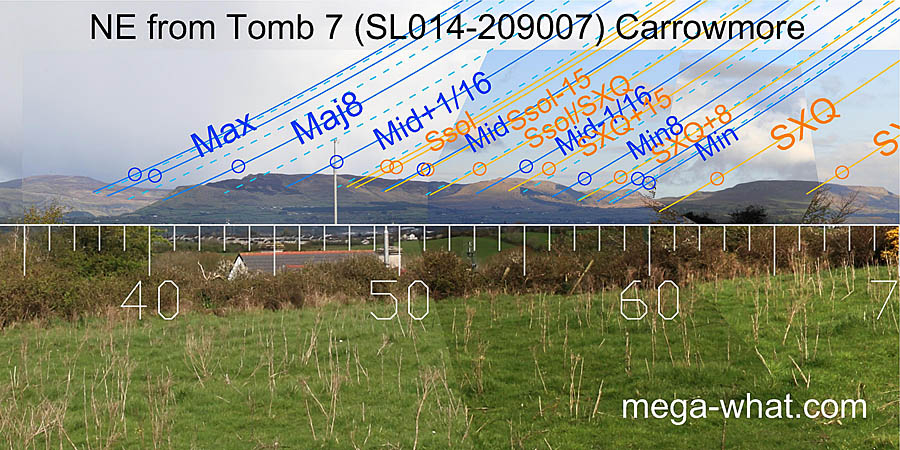 To the north-east is a useful run of hills which provides markers for just about everything.
To the north-east is a useful run of hills which provides markers for just about everything.
The positional difference of c.200m has shifted things noticeably along the ridge compared to Tomb 3. The ends of the lunisticeLunistices are the most northerly and southerly moons of the month. The lunar equivalent of solstices - more. zone are no longer in the dips but on the slopes. The solstice / cross-quarter midpoint is now in a dip.
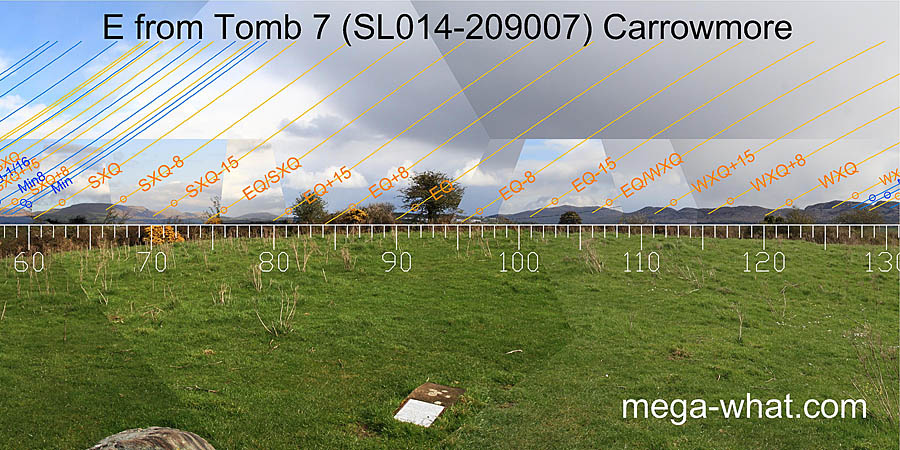 The eastern view should clearly be of distant hills but is partly obscured by trees and a hedge.
Again, the distinct shift is noticeable with the cross-quarters no longer skimming slopes to mention but one difference.
The eastern view should clearly be of distant hills but is partly obscured by trees and a hedge.
Again, the distinct shift is noticeable with the cross-quarters no longer skimming slopes to mention but one difference.
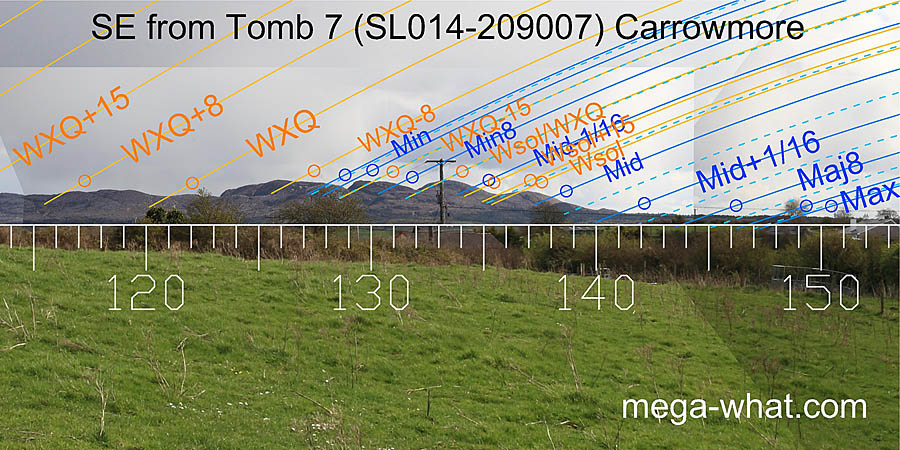 As before, more hills to the south-east provides various markers both solar and lunar but do not run far enough to reach the major end of the lunisticeLunistices are the most northerly and southerly moons of the month. The lunar equivalent of solstices - more.
range.
The fit is arguably slightly better from here though.
As before, more hills to the south-east provides various markers both solar and lunar but do not run far enough to reach the major end of the lunisticeLunistices are the most northerly and southerly moons of the month. The lunar equivalent of solstices - more.
range.
The fit is arguably slightly better from here though.
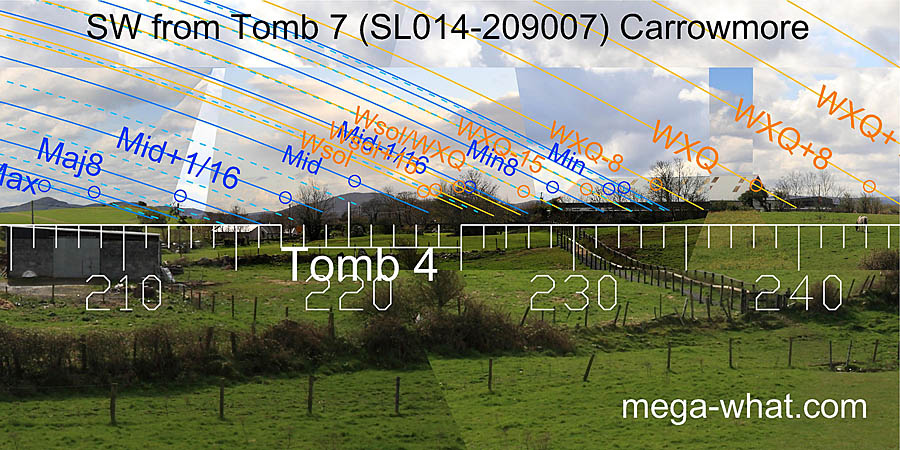 The south-western horizon is partly obscured by trees and farm buildings but less so than sites nearer to it and the fit is obviously good.
The south-western horizon is partly obscured by trees and farm buildings but less so than sites nearer to it and the fit is obviously good.
About 150m away in this direction is Tomb 4 which has not been excavated.
55m beyond it is Tomb 3, which was excavated by Burenhult and dated to about 5000 BCE, and slightly further away are tombs 2 & 1. Part of tomb 1 was excavated in 1995-96 and a charcoal sample was dated to c.4350 BCE.
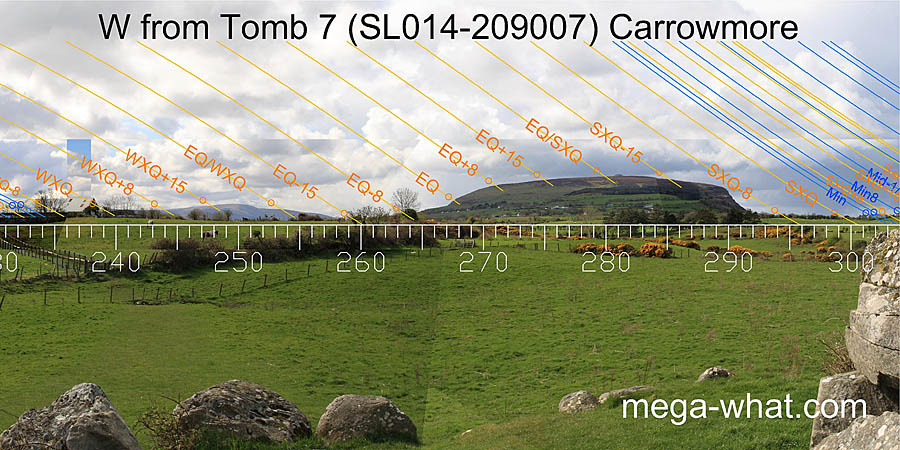 This site has views of Knocknaree and beyond that are not visible or obscured from tombs 3 & 4.
There is not much apparent in the way of accuracy however, except that the half-month bracket south of the equinox occurs in the notch formed by the intersect of local and further horizons.
This site has views of Knocknaree and beyond that are not visible or obscured from tombs 3 & 4.
There is not much apparent in the way of accuracy however, except that the half-month bracket south of the equinox occurs in the notch formed by the intersect of local and further horizons.
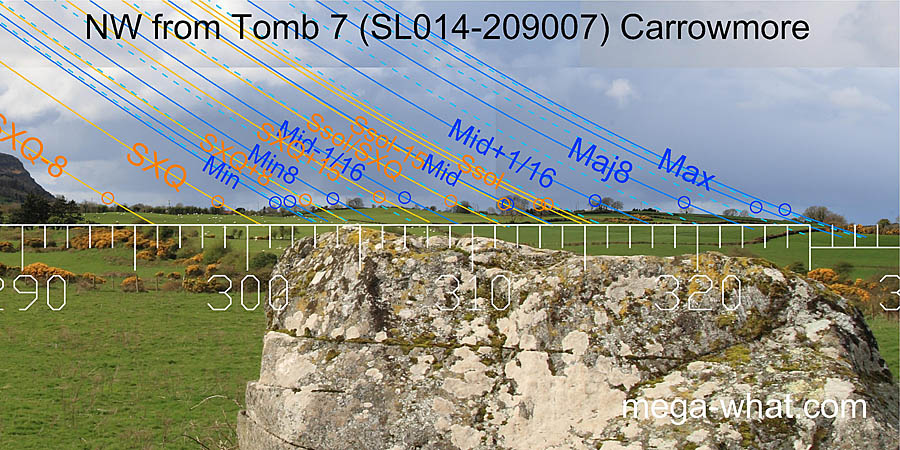 The north-western horizon is in the middle distance where the lunisticeLunistices are the most northerly and southerly moons of the month. The lunar equivalent of solstices - more.
range drapes itself conveniently across two low hilltops.
The north-western horizon is in the middle distance where the lunisticeLunistices are the most northerly and southerly moons of the month. The lunar equivalent of solstices - more.
range drapes itself conveniently across two low hilltops.
Carrowmore Megalithic Cemetery is quite extensive, with many tombs.
Click here for a map and more information.
References
- Archaeological Survey of Ireland, record details. www.archaeology.ie/archaeological-survey-ireland
- BURENHULT GÖRAN 2001 Illustrated Guide to the Megalithic Cemetery of Carrowmore Co. Sligo. Tjörnarp, Sweden. p20.
- EGAN URSULA et. al. 2008 Archaelogical Inventory of County Sligo. Dublin: Stationary Office.
- Ó'NUALLÁIN, SEÁN 1989 Survey of the Megalithic Tombs of Ireland, Volume V: Sligo. Dublin: Stationary Office.
